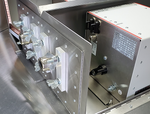CISPR 25 Edition 4 5uH LISN/AN Requirements & Equipment

Line Impedance Stabilizations Networks
Line impedance stabilization networks also called LISNs or artificial networks (AN) typically have three main functions:
- 1) Provide Stable Impedance (50Ω) on mains
- 2) Block RF Signals on Mains from Entering EUT
- 3) Provides Measurement Port[1]
These type of devices are most commonly categorized by the inductance (commonly 5μH or 50μH), current and voltage, as well as by design; with V-LISNs being the most commonly used[2]. LISN/AN are often used in both immunity and emissions testing on both AC and DC power lines.
5μH LISNs/AN

5μH LISNs are primarily used for automotive and military applications, which often cover from 100 kHz to upwards of 400 MHz. Given the 10 uF requirements of RTCA/DO-160, these are typically provided with the LISNs for compliant solutions. While the requirements behind the capacitors are the same, the methodology behind the how they're applied to the LISNs can differ by manufacturer.
Taking a look at the table you can see many of the common 5μH standards, the associated frequency ranges, and simulated impedances. It is important to note, that while the inductance, indicated in microhenries, remains the same the resistance can vary by standard.
Our focus is mainly on CISPR 25 and the new high voltage requirements in the newest 4th edition.

CISPR 25 LISNs/AN

CISPR 25 edition 4.0 2016-10 was released 10/27/2016 and can be purchased through the IEC webstore. This version replaces the 2008 version of this standard the committee is also currently working on a 5th edition which is set to be published in January 2022[3]. CISPR 25 pertains to both vehicles and boats and this newest versions includes specific requirements for electric and hybrid vehicles.
The majority of information regarding line impedance stabilization networks is included in section 6, with additional information in annex E and annex I. Annex E will be the main focus of our discussion as it provides the differentiation between high voltage and low voltage artificial networks as well as other monitoring components. To the right you will find the impedance curve provided in the EM Test AN 200N100 user manual.
CISPR 25 LV LISNs/AN

Prior to edition 4.0, there was no requirements to differentiate between the higher voltage and lower voltage, allowing the same AN to be used throughout for DC power supplies. This also allowed for the same LISN to be used for ISO 11452-4 as well as CISPR 25 requirements. Many of the LISNs designed prior to ed. 4.0, like the Schwarzbeck NNBM 8124 series can only be used for the LV portion of CISP 25.
Edition 4 placed new requirements for low voltage (LV) testing below 60 volt and high voltage (HV) above the 60 volt threshold. Section 6.1 provides the guidelines for LV component level testing, and provides a setup only requiring LV AN be used. The diagram on the right, taken from the Teseq HV-AN 150 manual, provides a simplified circuit of the LV CISPR 25 requirements. You will notice that these ANs do not require any shielded enclosures/containers. That will be discussed further in the newer HV requirements.
CISPR 25 HV LISNs/AN

The requirements for HV ANs in CISPR 25 edition 4 begin above 60 volts and apply to any components or systems in electric vehicles connected to any systems either HV or with both HV and LV. This is a particularly important distinction between edition 3 as it applies the new design of artificial networks to many electrical components and systems within electric or hybrid vehicles.
On the right you will see a simplified diagram designed around the newer HV requirements presented in Annex E.2.2. When considering testing components used in EV systems, it is important to note that both HV and LV LISNs will need to be used in some situations. This is discussed in more detail in Annex I, but will include onboard charges and DC-DC-converters.
Another new consideration for LISNs is a shielded enclosure or shielded box requirement for HV testing. These are designed according to section E.3 which includes the most common design of the HV AN for shielding between LISNs in a single box.
Common Questions
What are 5uH Line Impedance Stabilization Networks (LISNs)?
5uH LISNs (artificial networks) are designed mainly for conducted emissions testing for automotive, avionic, and military testing providing a stable impedance and monitoring port.
Can I use existing LISNs/ANs for CISPR 25?
Yes, typically you can use existing LISN for CISPR 25 (editions 3 or before) tests mainly below the 60 Volt limit. For testing to edition 4, the LISNs must comply with the new requirements for high voltage testing presented in the standard.
References/Additional Resources
[1] Rohde Schwarz. (2020, April 15). Understanding LISNs [Video]. YouTube. https://www.youtube.com/watch?v=QPJzp66Yvzs&t=142s
[2] User, S. (n.d.). LISN / AMN. Schwarzbeck Mess-Elektronik. Retrieved July 16, 2021, from http://www.schwarzbeck.com/en/lisn-line-impedance-stabilisation-networks.html
[3] International Electrotechnical Commission. (n.d.). IEC. IEC Webstore. Retrieved July 16, 2021, from https://webstore.iec.ch/publication/26122
1)https://cdn.shopify.com/s/files/1/1826/1151/files/HV_AN_150_datasheet_e04_16.pdf?v=1623185294


